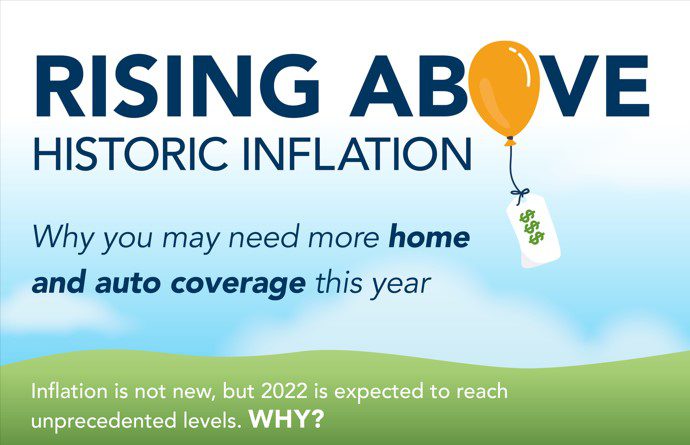How Inflated Material Costs Affect Insurance Premiums

How Inflated Material Costs Affect Insurance Premiums
You have probably noticed higher prices in many areas of your life. From gas to groceries, prices are going up with the U.S reaching inflation levels never seen before – and the insurance industry is not immune to this trend. Across the industry in most markets and with most insurance companies, whether you’ve had a claim or not, home insurance premiums are rising due to a variety of factors. Many of these factors are out of your control, as well as your agent’s and insurance company’s. Many current conditions, including increased costs of material and labor, as well as an ongoing shortage of workers means you may see a rise in your premiums at renewal time. If you have any questions, contact our office at 413.475.7283 or Complete our online quote form today!
What factors influence home insurance rates?
Rates are determined by the likelihood of a homeowner filing a claim and the potential risks involved. Home insurance rates are driven by numerous standard factors, including:
Amount of coverage needed
Age of the home
Location
Liability issues
Previous claims
There are other influencers caused by national trends which also contribute to rates.
Why are home insurance rates going up?
The biggest cause of rates going up is the rise in inflation. When prices rise, the cost of living and owning a home increases, which in turn influences home insurance rates. These rate increases are happening in insurance companies across the country.
Home insurance premiums can be affected by influencers outside of your control. Various nationwide factors are impacting the cost to rebuild homes, leading to the need for more coverage in case of a claim. Some of the trends that are driving up costs include higher material costs and supply chain issues. For instance, materials to rebuild homes are up 26%. Labor shortages are resulting in longer construction and claims handling times, which also impact the cost of claims.
Higher material costs
From record high prices to shortages of materials, the home building industry has seen lengthy delays, increased prices and a large number of postponed projects. These higher prices for construction projects, renovations and repairs lead to higher costs for homeowners.
These higher prices for construction projects, renovations and repairs lead to higher costs for homeowners.
With the price of building materials, such as drywall, shingles, lumber and copper wiring, up an average of 26%, homes have become more expensive to fix and replace. According to a survey completed by the National Association of Home Builders, this is the largest single year increase in the survey’s history.
Ninety three percent of contractors are impacted by the increased price of materials which leads to higher replacement cost when insurance claims are filed.
Increased shipping costs and delays
The pandemic has impacted almost every part of the global supply chain causing shipping delays and higher prices. When shipping ports get overwhelmed and backed up, it impacts the time it takes to get materials to homeowners and the cost of delivering the materials. From appliances to plumbing fixtures, it’s taken weeks and months longer to get building supplies, which previously had taken days to get.
94% of Fortune 1000 companies have reported supply chain disruptions from COVID-19.
Globally, RBC Capital Markets reported 77% of ports are experiencing abnormally long times to turnaround traffic.
In fact, Freightos.com marketplace data shows that in September 2021, China-US ocean shipments took an average of 73 days to arrive at their final destination, 83% longer than in September 2019.
Higher labor costs
Builders often hire sub-contractors who handle electrical, drywall, plumbing and other areas of construction. With the current labor shortages, higher costs are needed to secure skilled laborers or obtain the needed materials. This in turn has forced home builders to factor in higher costs for construction and remodeling work.
Eighty-nine percent of contractors are having a hard time finding craft workers and 88% of firms are experiencing project delays.10
Additionally, the U.S. is seeing a drop in the number of Americans becoming tradespeople. The National Electrical Contractors Association reports that 7,000 electricians join the field annually, but 10,000 retire.11 This shortfall results in higher prices and longer wait times for home projects.
Is home insurance the only coverage impacted by current trends?
Auto insurance is also experiencing increases due to national trends. Used car prices are up 40%, the cost of labor for repairs is up, car parts are costlier and harder to obtain due to supply chain issues, and rental car costs are up 30%. These factors and others are contributing to a rise in auto insurance rates.
Questions? Contact an agent with Encharter Insurance at (413) 475-7283 or visit www.encharter.com to learn more.
Chat with an Encharter agent about your insurance today:
413.475.7283
Complete our online quote form
Source: https://www.hanover.com/resources/tips-individuals-and-businesses/prepare-now-learn-how/understanding-historic-inflation
Read More
amherst, auto, auto insurance, boat, boat insurance, business, business insurance, commercial auto insurance, commercial property insurance, Condo, condo insurance, Employee Surety Bond Insurance, Encharter Express, excess liability, flood insurance, General Business Liability, General Contractor Insurance, home, Home Business Insurance, home insurance, Home Insurance Rates, homeowners, homeowners insurance, Increasing Rates, Inflated Material Cost, Insurance for Restaurants, Insurance Premiums, Labor Costs, Lexington, Life, MA, Massachusetts, Material Cost, motorcycle, motorcycle insurance, Personal, personal insurance, Personal Umbrella Insurance, Pioneer Valley, renters insurance, restaurant, restaurant insurance, Shipping Costs, small business insurance, specialty insurance, Trends, umbrella insurance, workers comp, workers comp insurance, workers compensation






